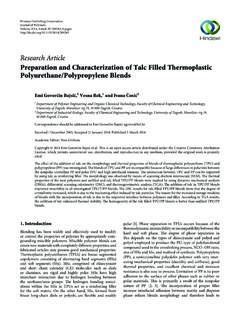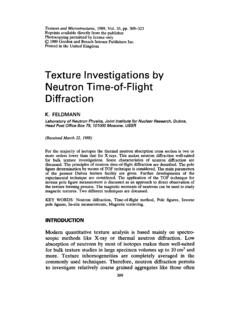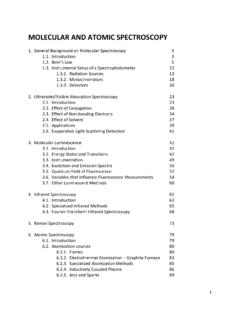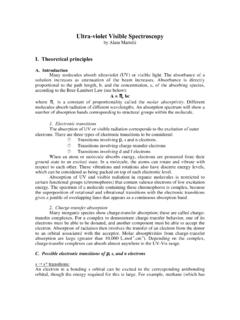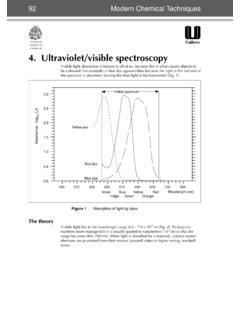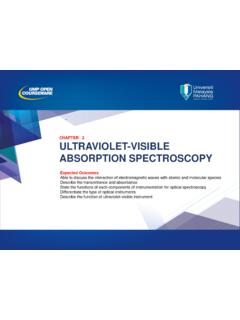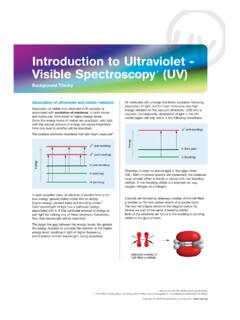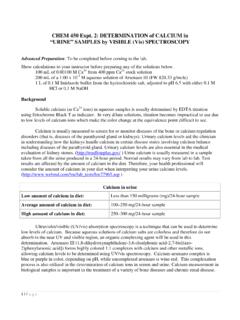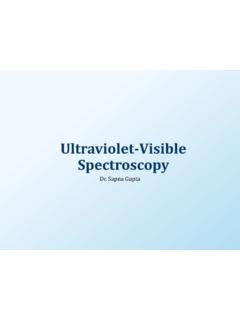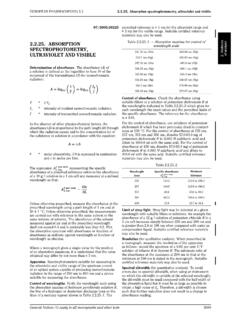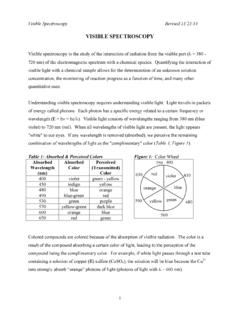Transcription of Research Article Ultraviolet-Visible and Fluorescence ...
1 Hindawi Publishing CorporationBioMed Research InternationalVolume 2013, Article ID 652604,8 ArticleUltraviolet- visible and Fluorescence SpectroscopyTechniques Are Important Diagnostic Tools duringthe Progression of Atherosclerosis: Diet Zinc SupplementationRetarded or Delayed AtherosclerosisMohamed Anwar K. Abdelhalim,1 Sherif A. Abdelmottaleb Moussa,2,3and Yanallah Hussain AL-Mohy11 Department of Physics and Astronomy, College of Science, King Saud University, Box 2455, Riyadh 11451, Saudi Arabia2 Department of Physics, College of Science, Al-Imam Muhammad Ibn Saud Islamic University, Box 90950,Riyadh 11623, Saudi Arabia3 Biochemistry Department, Biophysics group, National Research Centre, Dokki, Giza, EgyptCorrespondence should be addressed to MohamedAnwar K.
2 Abdelhalim; 23 June 2013; Revised 27 August 2013; Accepted 28 August 2013 2013 Mohamed Anwar K. Abdelhalim et al. This is an open access Article distributed under the Creative CommonsAttribution License, which permits unrestricted use, distribution, and reproduction in any medium, provided the original work isproperly this study, we examined whether UV- visible and Fluorescence spectroscopy techniques detect the progression ofatherosclerosis in serum of rabbits fed on high-cholesterol diet (HCD) and HCD supplemented with zinc (HCD + Zn) Chow supplemented with cholesterol plus olive oil (100 g/day)
3 For the same period. The HCD + Zn group was fed onnormal Purina Certified Rabbit Chow plus cholesterol and olive oil supplemented with 470 ppm Zn for the same feedingperiod. UV- visible and Fluorescence spectroscopy and biochemistry in Rabbit s blood serum and blood hematology were measuredin Rabbit s found that the fluorescent peak of HCD shifted toward UV- visible wavelength compared with thecontrol using fluorescent excitation of serum at 192 nm. In addition, they showed that supplementation of zinc (350 ppm) restoredthe fluorescent peak closely to the control.
4 By using UV- visible spectroscopy approach, we found that the peak absorbance of HCD(about 280 nm) was higher than that of control and that zinc supplementation seemed to decrease the demonstrates that Ultraviolet-Visible and Fluorescence spectroscopy techniques can be applied as noninvasive techniques on asample blood serum for diagnosing or detecting the progression of atherosclerosis. The Zn supplementation to rabbits fed on HCDdelays or retards the progression of atherosclerosis. Inducing anemia in rabbits fed on HCD delays the progression of BackgroundAtherosclerosis is the primary cause of coronary and car-diovascular diseases.
5 Atherosclerosis and heart diseases aremajor causes of morbidity and mortality in adults in ,astenoticlesionofarterialwalls, is a leading cause of death affecting almost one third ofhumans in developed countries. It can generally be viewedas a form of chronic inflammation that is induced andperturbed by lipid accumulation [1,2]. Hyperlipidemia or ahigh serum triacylglycerol and cholesterol level is consideredan important risk factor for the progression of causes of atherosclerosis are mainly due to lifestyle,cholesterol-rich diet, and hereditary [3].
6 Atherosclerotic lesions are characterized by progressivethickening of the arterial intima layer due to cellular prolifer-ation (foam cells), lipid and cholesterol deposition. Followingextracellular lipid accumulation, there is a change in elastinlayer and enlargement of upper intima with development ofa collagenous cap or fibroatheroma plaque. In advancedlesions lipid and necrotic deposits accumulate within theintima, and calcium crystals build-up takes place, leading2 BioMed Research Internationalto the ultimate calcification of artery wall.
7 Although manytherapies are available for treatment, usually the physician sintervention occurs when the plaque is symptomatic, withhigh commitment of important organs that need high bloodsupply, such as heart and brain [4 7]. Fluorescence spectroscopy has been recently explored asanewtechniqueforthediagnosisofdiseasei nhumantissue[8 11]. Several groups have demonstrated that normal andatherosclerotic human artery can be differentiated on thebasis of their Fluorescence emission spectra. Many have sug-gested that this represents a new technique for determiningthe histochemical composition of atherosclerotic plaqueinvivoand potentially guiding laser angiosurgery catheters [8 10].
8 Similarly, it has been shown that neoplastic tissue canbe discriminated from nonneoplastic tissue, in a variety oforgans, including the colon [10]andlung[12]onthebasisof tissue Fluorescence emission has been reported that feeding rabbits a high-choles-terol diet resulted in alterations in prooxidant-antioxidantstatus in several tissues as well as typical atheroscleroticchanges in the aorta [13 16]. Fluorescence is the emission of light by a substancefollowing absorption of light or other electromagnetic radi-ation of a different wavelength.
9 In most cases, the emittedlight has a longer wavelength, and therefore lower energy,than the absorbed radiation. However, when the absorbedelectromagnetic radiation is intense, it is possible for onemolecule to absorb two photons; this two-photon absorptioncan lead to emission of radiation having a shorter wavelengththan the absorbed Fourier-Transform Raman (FT-Raman) spectrosco-py is an optical tool which permits less invasive and nonde-structive analysis in biological samples with high precision,allowing one to get precision information of biochemicalcomposition from different types of human tissues such ascoronaryarteries,lung,andcolonwithoutt issueremoval[17 19].
10 The optical diagnosis has been used in a variety of humandiseases, such as near-infrared Fluorescence spectroscopyof Alzheimer disease, near-infrared Raman spectroscopy ofcervical precancers, and human breast cancer there is no noninvasive clinical method avail-able for detecting or diagnosing atherosclerotic plaque con-tent without withdrawing tissue. The Ultraviolet-Visible andfluorescencespectroscopytechniqueshav enotbeenwelldocumented in rabbits blood fed on high-cholesterol diet(HCD) and HCD supplemented with high zinc (Zn) , the aim of this study is to diagnosis or detect theprogression of atherosclerosis as well as the delay or retardof the progression of atherosclerosis applying Ultraviolet-Visible and Fluorescence spectroscopy techniques on rabbit sblood sample.



